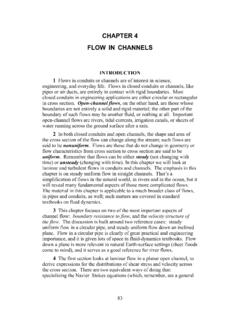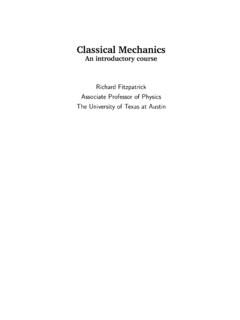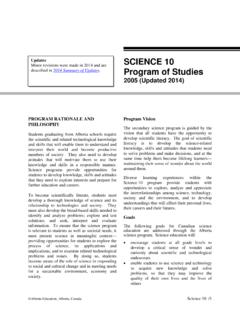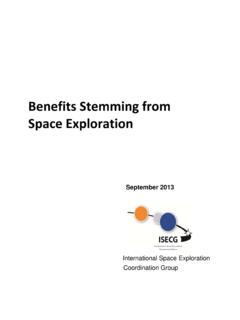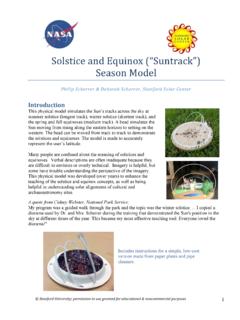Transcription of Introduction to Satellite Communications Technology for NREN
1 NAS Technical Report NAS-04-009 August 2004 Introduction TO Satellite COMMUNICATIONSTECHNOLOGY FOR NRENTHOM STONE, RAYTHEONMAILSTOP 258-6 NASA AMES RESEARCH CENTERMOFFETT FIELD, CA INTRODUCTIONNASA Research & Education Network (NREN) requirements for development ofseamless nomadic networks as well as our association with other space-based projectssuch as the Protocol Testbed and EOS necessitates that NREN staff have a workingknowledge of basic Satellite Technology . This paper and the presentations given insummer and fall of 2002 are designed to impart this timely knowledge.
2 This paperaddresses the components required for a Satellite -based Communications system,applications, Technology trends, orbits, and spectrum, and hopefully will afford the readeran end-to-end picture of this important are objects in orbits about the earth . An orbit is a trajectory able to maintaingravitational equilibrium to circle the earth without power assist. Physical laws that wereconceptualized by Newton and Kepler govern orbital to Satellite Communication Technology for NREN2 The first Satellite was the Moon, of course, but the idea of Communications satellitescame from Sir Arthur C.
3 Clark in 1945. The Soviets launched the first manmade Satellite ,Sputnik 1, in 1957. The first Communications Satellite (a simple reflector) was the 1 in 1960. The first geosynchronous (explained later) Satellite , Syncom, went upin 1962. There are now over 5000 operational satellites in orbit, 232 of which are largecommercial (mostly Communications ) have become essential for modern life. Among the important applications ofsatellite Technology are video, voice, IP data, radio, earth and space observation, globalresource monitoring, military, positioning (GPS), micro-gravity science and many direct-to-home TV to the Hubble telescope, satellites are one of the definingtechnologies of the modern age.
4 Video is the most successful commercial application forsatellites, and direct-to-home distribution is the most promising application for thetechnology at this time. Spot images of places on earth , GPS, and Internetaccess both for providers and direct-to-home or office have been most successful,while cell phone systems based on fleets of low flying satellites have been a flop. Mobilephone-like connections (including at ISDN speeds) for marine and mobile services havebeen with us for some time, services have some big advantages, such as being available almost everywhereon earth without wires, being mobile, being the perfect broadcast medium, and beingprotocol agnostic.
5 The downside to Satellite Technology is that satellites have either alimited visibility over a spot on earth , or a long round-trip time, and they broadcast datathat can be received by anyone under them. Satellite transmissions are also affected byboth terrestrial and space weather. They are subject to a higher error rate than fiber, andthey are complex from both a physical and regulatory point of are launched from earth by the shuttle, from high-flying airplanes, or fromground-based rockets. Once launched, payloads must reach proper elevation and escapevelocity to be boosted into orbit.
6 In order to maintain proper orbit, satellites arecontrolled from a ground station on earth that sends commands and receives status andtelemetry from the ORBITSS atellites are classified by the distance of their orbits above the earth . Low EarthOrbiting (LEO) satellites are located at an altitude of from 100 to 1200 miles, andMedium earth Orbits (MEO) are located at an altitude of from 4,000-12,000 miles. Geo-stationary orbits are located exactly miles high. There are two Van Allen radiationbelts around the earth . These areas of intense radiation are to be avoided in deployingsatellites.
7 The two zones separate LEO and MEO and MEO (sub-geosynchronous) orbiting satellites are visible for only a period oftime from the point of view of an observer on earth . Satellites in these orbits cancommunicate with the earth by pass off to a fleet of like satellites providing full Earthcoverage. They can also pass off to a geosynchronous relay Satellite , or they can dumpdata to the ground as they pass over a ground station. Most of these near earth satellitesIntroduction to Satellite Communication Technology for NREN3are in orbits that go over or near the poles; some go over the same place on earth at leastseveral times a day.
8 The coordination and placement of earth stations to operate andtake data from these satellites is a major consideration in the life cycle of a Satellite . Theadvantage of sub-geo satellites over those in geosynchronous orbit is that lower orbits areless expensive to launch, it takes less power to send and receive data, and the round triptime from earth is (Twelve Hour Eccentric Orbits, or Molniya orbits) are not quite polar orbits thatstay in a hemisphere for half of a day. This approach allows for two MEO satellites tocover an area of the earth , thus giving continuous service as a geosynchonous satellitewould.
9 This was developed and used extensively in orbits are the most desirable and the most expensive to obtain. Geosynch satellites appear stationary to observers on the earth . The orbit is always atthe equator at a height of 23,400 miles; the Satellite thus travels in the same direction andspeed as the rotation of the earth . These satellites, because they provide continuouscoverage, are the workhorses of the commercial Satellite industry. Geosynch satellitesmust be spaced at least 1/2 a degree apart to prevent signal interference. Slots areclosely regulated by the International Telecommunications Union ( ).
10 They arehighly sought after and expensive to acquire, and since geosynch orbits are alsoexpensive to launch and maintain, most satellites in this orbit are big and orbits require at least a quarter second round-trip time because of the23,400-mile distance above the earth plus the distance to the equator from the groundstation. More power is also needed because of the distance (although a larger antenna onsome satellites mitigates some of this). Since geosynch satellites are always inapproximately the same place with regard to the earth , it is possible to precisely map a footprint so that users can calibrate ground station equipment to minimize power to Satellite Communication Technology for NREN4 Geosynch satellites are kept tightly in their orbits by expending fuel.

